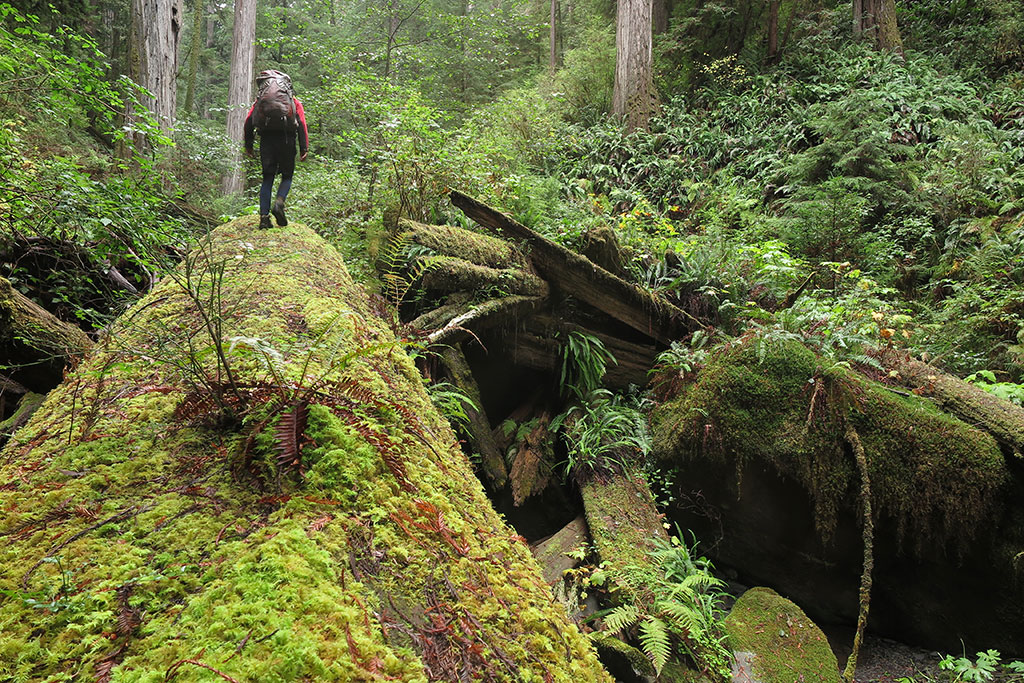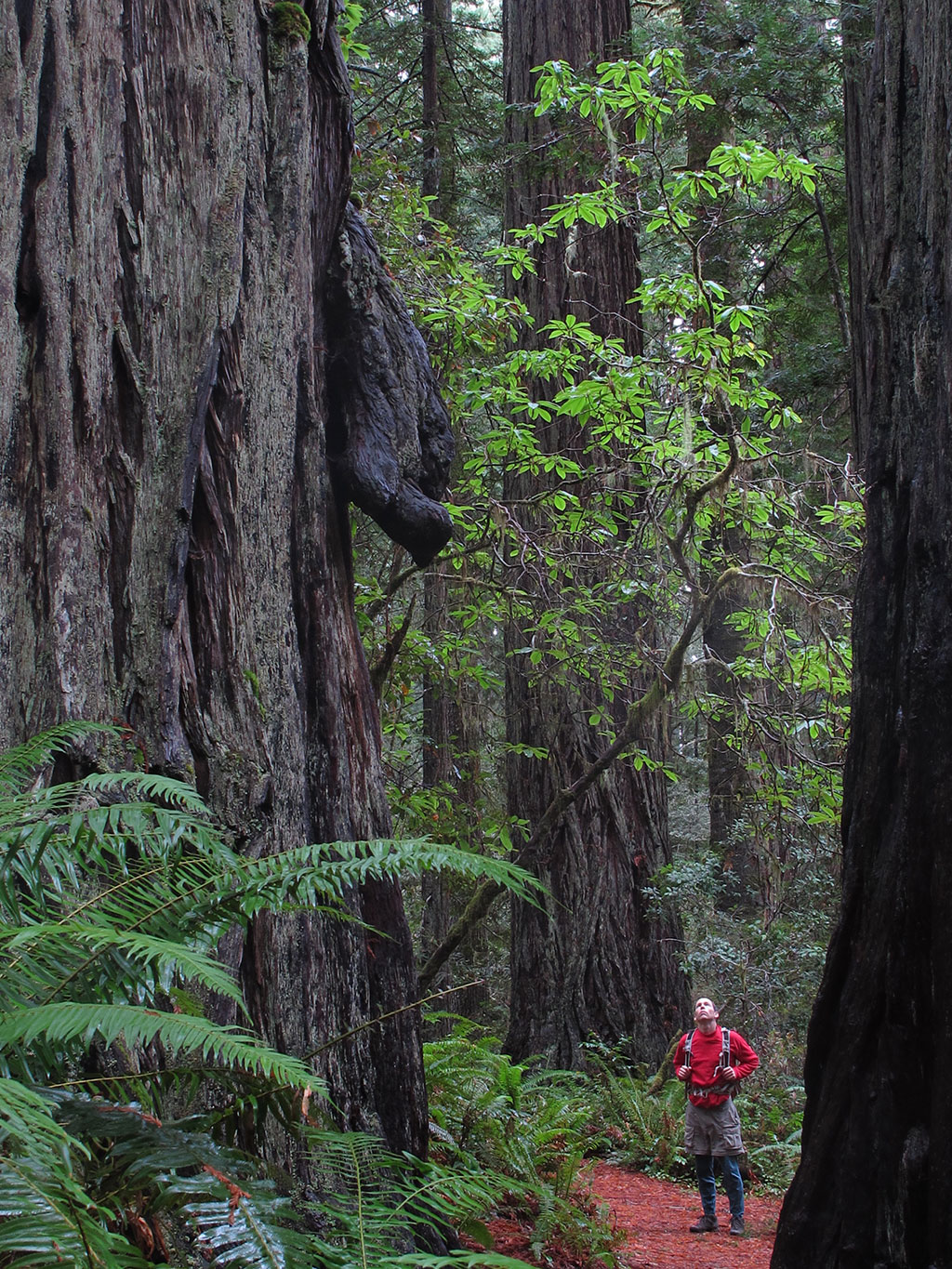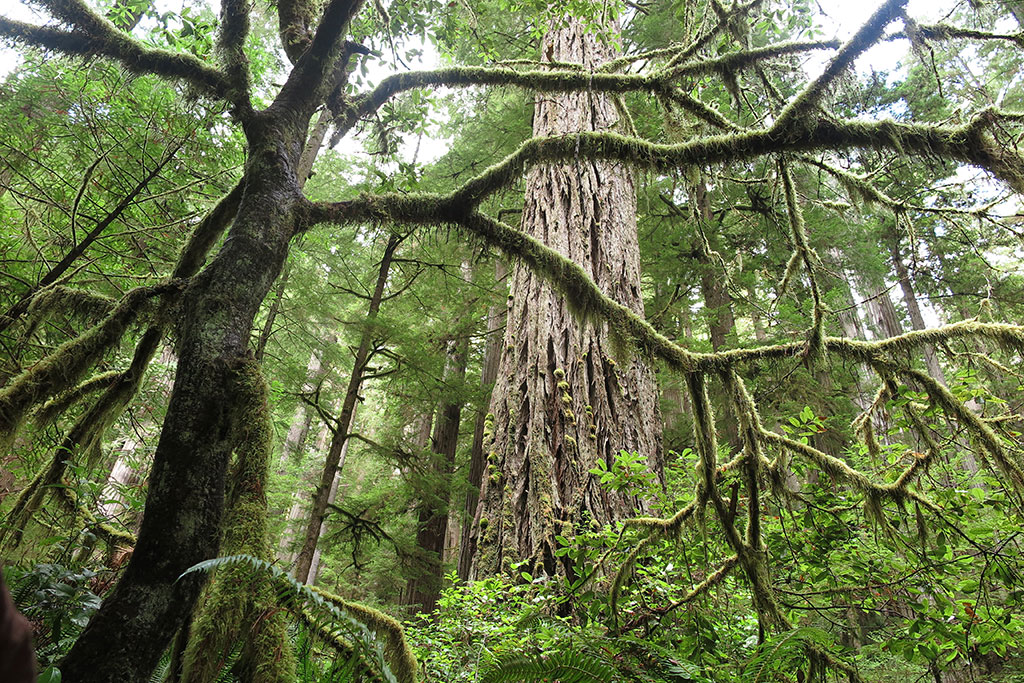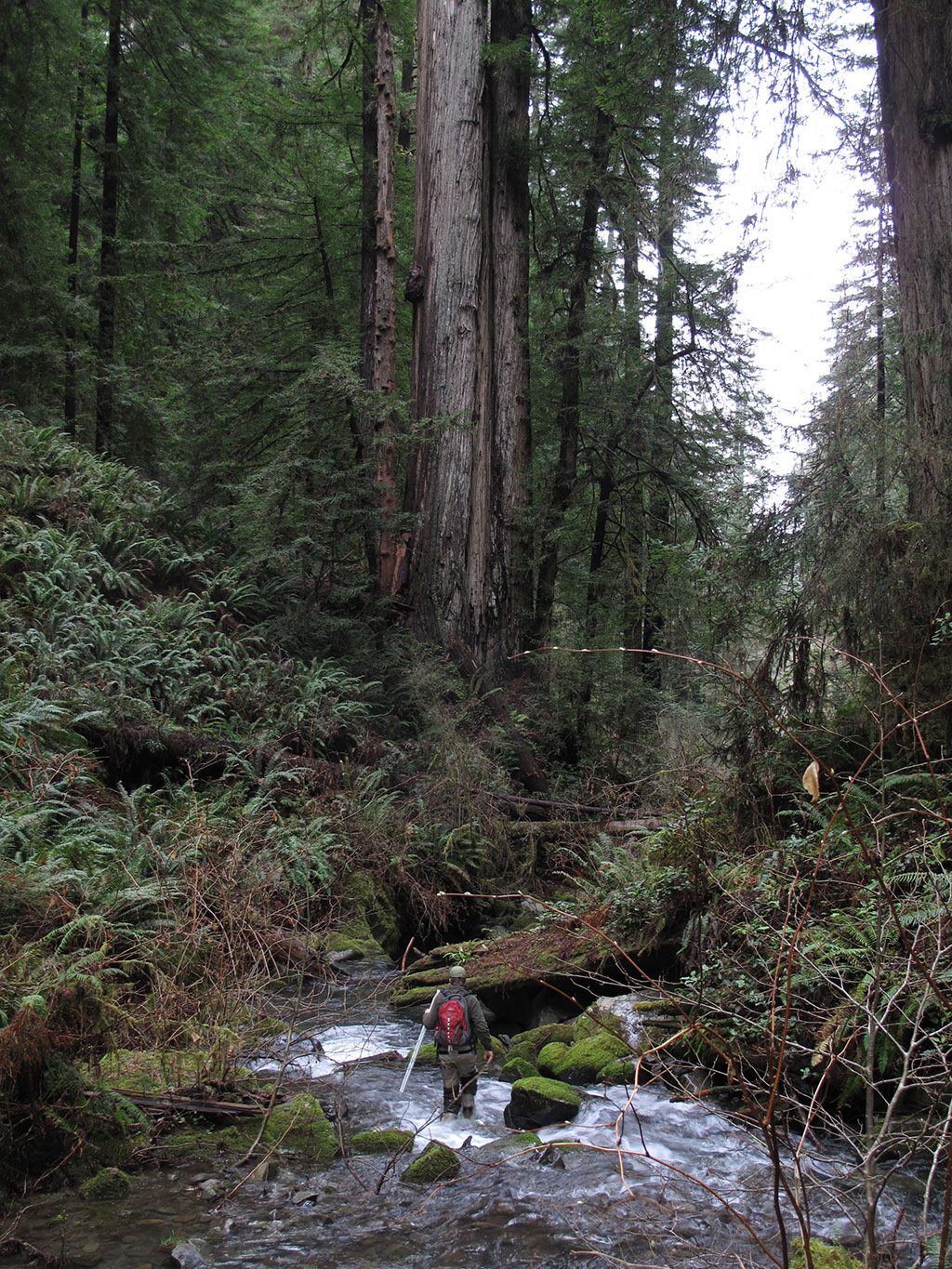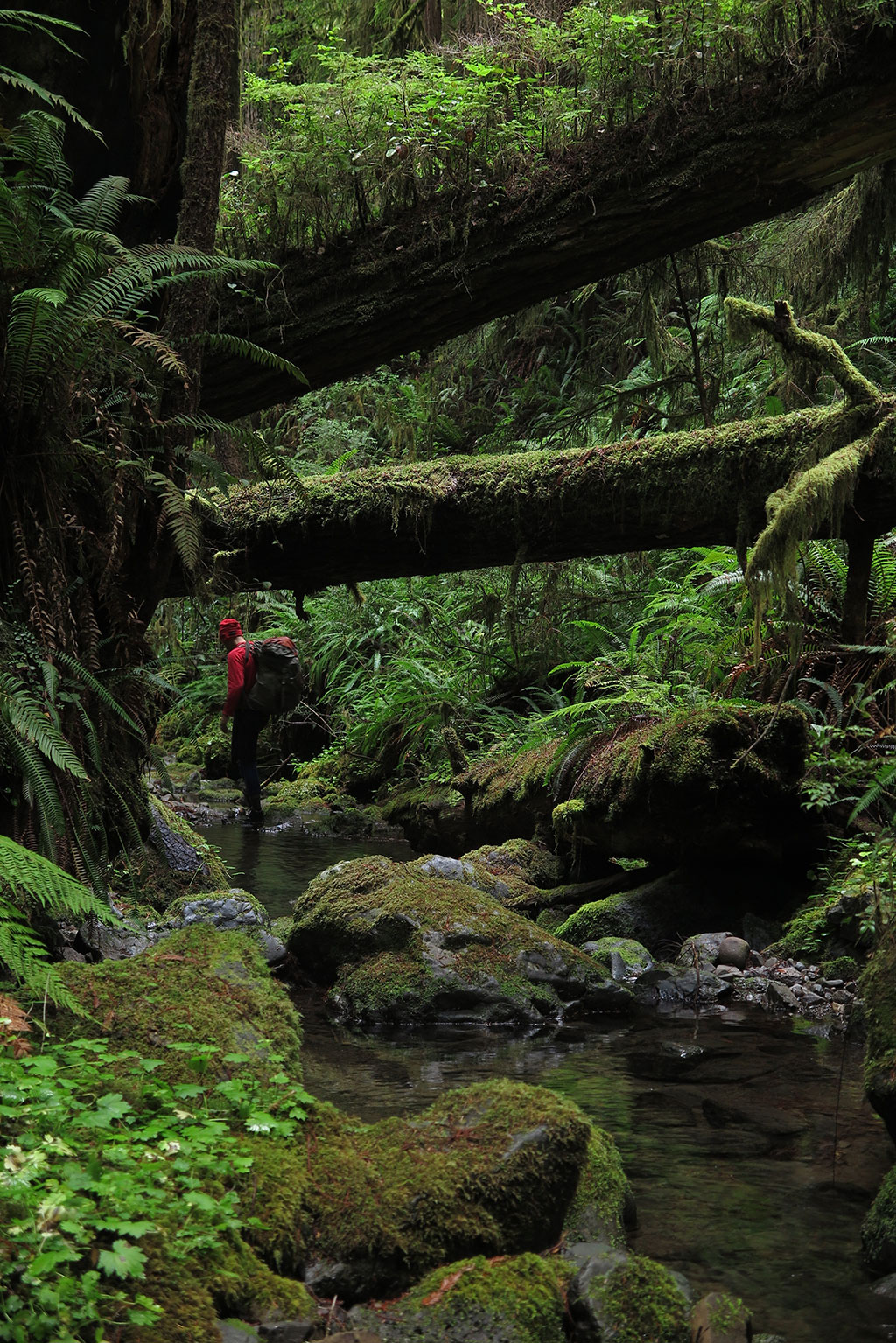An adventurous journey through Little Lost Man Creek points to the importance of watershed protection.
By Tyler Williams
The dim light of a redwood forest makes it difficult to discern the onset of dusk. Shadows of the woods creep up on you, growing almost imperceptibly until suddenly, it’s night. This flip of the forest light switch felt imminent as I stood scratching my head, trying to find myself among the wavy lines of a damp and tattered paper map.
The distant rumble of a logging truck unexpectedly drifted through a cathedral of tree trunks to my left. This presented me with a dilemma. Although I’d been struggling along game trails for two hours, the security of my vehicle was evidently not far away. My intended destination, on the contrary, lay far below in a steep, dark, densely forested canyon known quite cryptically as Little Lost Man Creek. I stood there indecisively in the fading light, giving myself a pep talk to try and ratchet up my courage. Just then, it was easy to understand how these forests were once seen as an oppressive and menacing force, and how appealing it must’ve been to overcome that force and bring light to the wilderness, to chop it all down.
This was exactly the course of things in the late 1800s, after California’s gold rush brought a flood of immigration. The great cloak of redwood forest, once filling every fog-shrouded river valley from San Francisco to Oregon, began to get chipped away. Progress was slow during the first 50 years of this systematic logging, even after the invention of the steam donkey and the unscrupulous cunning of timber speculators who used a government loophole to acquire the vast majority of redwood country.
By the turn of the century, San Francisco’s progressive Sempervirens Club was gaining a small foothold in opposition to the juggernaut of redwood carnage, and a handful of societal elites were funding land grabs of their own, in the name of preservation. Congressman-philanthropist William Kent established and named Muir Woods in 1906, and a decade later a seminal redwood-saving road trip was undertaken by paleontologists John C. Merriam and Henry Osborn and controversial ethnographer Madison Grant. Their drive up the developing Redwood Highway — today’s Highway 101 — brought them past the giant trees of Bull Creek Flats, and this forest glen became a top priority for the newly formed Save the Redwoods League. The grove finally gained protection in 1931 when John D. Rockefeller donated $2 million for its acquisition. It was the single biggest victory of the preservationist movement at the time, but it would only be 15 years before it also became their biggest lesson.
Winter rains come in waves along California’s North Coast, tapping tropical moisture sources to spew inches of water in a matter of hours. During these episodes, the coast mountains become exceptionally dynamic. Landslides of mud slew downhill, big trees topple from gusts of wind upon loose saturated soil, rivers rage and claw at their banks. This has been going on for centuries. But, by 1955, the mountains surrounding Bull Creek were denuded, and, although the eye-popping trees of the valley were protected by law, an apocalypse began to unfold during a particularly drenching storm.
Scientists Douglas Jager and Richard LaVen’s assessment of the resulting flood paints a clear picture:
“The 1955 flood entrained a sawmill cold deck, cull logs, charred stumps, slash, houses, car bodies, propane tanks, mattresses, tires, and a few coffins, mixed them liberally with the products of erosion, and deposited them in the lower six miles of the Bull Creek channel.”
Dozens of big redwoods were lost due to bank failure, and the once quaint little creek was altered into a wide plain of sediment. The golden trophy of redwood preservation was ingloriously tarnished in a cake of mud.
Hastily constructed roads and clear-cut hillsides were the primary culprits for the destructive flood. With the heavy rain, erosion ran unchecked from a freshly exposed landscape that was once held together by a web of root and bush and raindrop-shielding canopy. In preservation terms, it was apparent that simply safe guarding the biggest trees was not enough. The Bull Creek flood prompted a more holistic view of old-growth stewardship. Save The Redwoods and California State Parks sprang to action, and, by the late 1960s, most of the Bull Creek basin was in some form of park management.
The new Bull Creek acquisitions were still underway as a second major flood came in 1964. This one had a far greater reach than the ‘55 flood, destroying not just the rehabilitation work that was underway on Bull Creek, but also damaging bridges and other infrastructure throughout the region. Questions about indiscriminate logging were now recognized not just by the conservationists but even among the general public.
This was the last chance to preserve an entire intact watershed of old-growth redwood. There were still a few out there. But, the wheels of change are grinding, and, by the time Redwood National Park was being pieced together between 1968 and 1978, the last of the old-growth valleys fell to the saw.
Ninety minutes north of Bull Creek, the basin of Redwood Creek became the most contentious part of park expansion, not just because there were big trees there but because the threats of upstream erosion were very real. Abandoned logging roads collapsed during floods in 1972 and in 1975, damaging some of the coveted big redwoods downstream. After a protracted battle, the Carter administration finally obtained the lower third of the watershed for park land in 1978. Like so many valleys behind the redwood curtain, much of Redwood Creek was logged before the legal deal was signed.
Little Lost Man Creek lies just over the ridge from Redwood Creek. It is a much smaller watershed. You could fit more than 20 Little Lost Mans within the valley of Redwood Creek. It lacks, too, the groves of giant trees found both in Redwood Creek and nearby Prairie Creek, a park centerpiece with a paved road and a web of trails. Little Lost Man quietly squeezes between the two, hidden within a cloak of green, unceremoniously holding the title of last undeveloped redwood valley. It is hardly a vast wilderness of redwood primeval, but it doesn’t take much for old-growth redwood to be a clandestine environment. Despite its diminutive proportions, Little Lost Man, I would learn, is pretty damn dank and wild.
When the forest’s eternal dusk finally fell into dark, I pitched my camp on a one-man gravel bar in the middle of the almost dry stream. From my sleeping bag, I could lean over and ladle out a cup of translucent creek water. Out the front door, a silver-barked redwood soared to a very average 250 feet, pointing to a narrow gap of stars. In the night I awoke to the hoots of an owl. In the morning, I followed the wet splotches of a bear’s pads for a time, hopping among the rocks of the creekbed.
The bruin’s soft, grippy paws would have been nice to have instead of my rubber-soled boots. Although the creek offered the best route of travel, it was hardly a boulevard. At a 6-inch-deep pool, snot-slick cobbles caused me to slip, then stumble, finishing with a full-on belly flop. I stood up dripping and looked around, as if someone was nearby to have witnessed the hilarious crash landing. My reaction was ingrained from similar episodes I’d experienced as a field technician, conducting salmon spawning surveys on this and other coastal streams. Such antics are a part of that job description, and always good for a laugh between survey partners.
On this October day, there was hardly enough water to qualify Little Lost Man as a salmon stream, but things change completely when the seasonal rains arrive. This is home to all four anadromous fish of the region: coho salmon, chinook salmon, steelhead and coastal cutthroat trout. They arrive once the creek gains a reliable surface flow, usually in November, to hollow out their nests — called redds — in the submerged gravels. After spawning, strategies vary for hatchlings of the various species. Some make an almost immediate migration to the sea while others take a full year’s residence in a deep pool of the creek before going to the big blue. One thing all anadromous fish need, however, is clean gravel and cold water, which brings us back to the importance of watershed protection.
Even a single disturbed roadcut can sully a stream during a large rain event, smothering a redd in mud and literally suffocating salmon eggs before they’ve had a chance to hatch. In undisturbed Little Lost Man, salmon thrive, along with other aquatic species like the tailed frog. Surveys have found roughly 1.0 tadpoles per square meter here. In actively logged drainages, that number drops ten-fold, to 0.1 tadpoles per square meter. This science might provide hard data, but to anyone who has walked both pristine and heavily logged drainages, it’s really just illustrating the obvious. Privately held timberland creeks are brown water mud pits for days after a heavy rain, while intact streams, like Little Lost Man, regain their clarity quickly, sometimes within 24 hours after the deluge.
This kind of natural buffer against big storms is just what we hope to regain with places like Bull Creek and the more recent acquisition of Mill Creek. This is the watershed of Jedediah Smith Park, where some of the biggest known redwoods lurk. From the 1950s until 2000, upper Mill Creek was managed for commercial timber. Today, nearly the entire watershed, about 25,000 acres, is in park hands. Even though few ancient trees were left to save, this was one of the biggest triumphs of redwood protection. The landscape and the creek, for more than a dozen years now, are on the mend.
Waterways like this support a web of life integral to the ecosystem, and it starts right at the headwaters. This is where the cold water that fish require emanates. And, because headwaters are generally steeper than lower reaches, disturbed sediments flush rapidly downstrem from headwater slopes to settle in low-gradient areas, where fish spawn. For the iconic salmon, the giant trees that shade their redds and keep the water cool, and everything else down to microorganisms in the bottom of the creek, headwaters are of critical importance. Clearly, redwood preservation is about more than just the big trees.
I tried to keep the importance of this ragged natural world in mind when I approached logjams that created 20-foot waterfalls in the creek. These barriers help slow down the floods and the sediment, as well as random hikers trying to bushwhack downstream. My low point came at a freshly fallen hemlock that was the latest layer in a logjam that completely obscured the creek. With no good option of weaseling my way under or around, I plunged ahead into the tangle, swinging my feet over a menagerie of horizontal limbs to probe for something solid underfoot. This worked, slow as it was, until my purchase gave way and the false floor exposed a 10-foot drop below that I might have plunged right through. But, there was no plunging. Arms, pack, crotch, all were hung up in the miasma of branches, thoroughly preventing any further descent. I rolled to a mossy log and crept by hand and foot down to the next level.
It was late afternoon by the time I rounded a corner to see a footbridge. From here a trail led less than a mile to the relative bustle of Highway 101. I can’t say it wasn’t a welcome sight. A comfy car, a smooth road, the redwood hot tub it might deliver me to; it was all quite luxurious and appealing upon emerging from an overwhelming copse of ancient forest.
With my spirit renewed, but my body craving civilized comfort, I couldn’t deny the societal benefits we’ve gained from the harvesting of those once infinite redwood groves. Fast growing, straight, massive, rot resistant, this was the greatest timber tree humanity has ever known. Plenty of Sequoiadendron sempervirens were used for important infrastructure of this continent. Looking back, it’s just unfortunate that we were so darn voracious about it, unable to spare just one significant watershed of old-growth redwood. A quick scan of the map reveals a number of potential basins that, in a perfect world, we might have preserved: Larabee Creek, Yager Creek, Lawrence Creek, Maple Creek, Blue Creek, Turwa Creek, even 65-mile long Redwood Creek, in the context of the entire redwood belt, would not have been over generous. But, just a century-plus after redwood logging commenced, the largest remaining watershed that is unlogged and undeveloped is 6-mile-long Little Lost Man. It’s not the redwood redoubt some of us might want, but it’s what we’ve got.
Tyler Williams is a big-tree hunter, adventure seeker and author of Big Tree Hikes of the Redwood Coast: A Guide to the Giants. To learn more, visit his website www.funhogpress.com.
